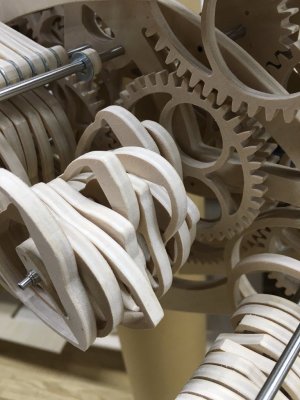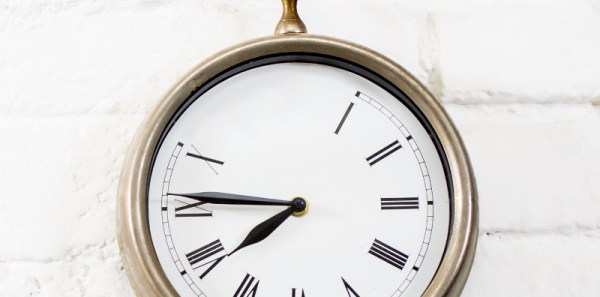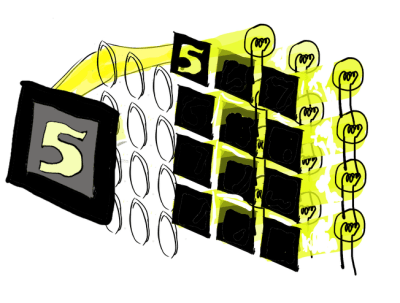Would you believe a pendulum clock that can keep time accurately to within one second per year? If you answered “yes”, you’ve either never tried to regulate a pendulum clock yourself, or you already know about the Shortt Clock. Getting an electromechanical device to behave so well, ticking accurately to within 0.03 parts per million, is no mean feat, and the Shortt clock was the first timekeeping device that actually behaves more regularly than the Earth itself. Continue reading “Retrotechtacular: The Best Pendulum Clock”
Set Your Clocks To Decimal Time
Many stop lights at street intersections display a countdown of the remaining seconds before the light changes. If you’re like me, you count this time in your head and then check how in sync you are. But did you know that if the French had their way back in the 1890s when they tried to introduce decimal time, you’d be counting to a different beat? Did you know the Chinese have used decimal time for millennia? And did you know that you may have unknowingly used it already if you’ve programmed in Linux? Read on to see what decimal time is along with the answers to these questions.
For Your Binge-Watching Pleasure: The Clickspring Clock Is Finally Complete
It took as long to make as it takes to gestate a human, but the Clickspring open-frame mechanical clock is finally complete. And the results are spectacular.
If you have even a passing interest in machining, you owe it to yourself to watch the entire 23 episode playlist. The level of craftsmanship that [Chris] displays in every episode, both in terms of the clock build and the production values of his videos is truly something to behold. The clock started as CAD prints glued to brass plates as templates for the scroll saw work that roughed out the frames and gears. Bar stock was turned, parts were threaded and knurled, and gear teeth were cut. Every screw in the clock was custom made and heat-treated to a rich blue that contrasts beautifully with the mirror polish on the brass parts. Each episode has some little tidbit of precision machining that would make the episode worth watching even if you have no interest in clocks. For our money, the best moment comes in episode 10 when the bezel and chapter ring come together with a satisfying click.
We feature a lot of timekeeping projects here, but none can compare to the Clickspring clock. If you’re still not convinced, take a look at some of our earlier coverage, like when we first noticed [Chris]’ channel, or when he fabricated and blued the clock’s hands. We can’t wait for the next Clickspring project, and we know what we’re watching tonight.
Continue reading “For Your Binge-Watching Pleasure: The Clickspring Clock Is Finally Complete”
Unusual 72-Bulb Display Mechanism Found In Vintage Clock
It’s hard to beat a vintage clock for something that you can hack, and that your significant other might actually let you display in your home. It’s practical and it’s art all at the same time! But, finding that perfect vintage clock for restoration can be a bit tricky. A crowd favorite is to choose something with intricate mechanisms and gears — the motion of a mechanical display is just so fascinating.
[Gavin] managed to find a clock that is every bit as interesting without any moving parts. The clock uses a unique system of bulbs and screen masks to project each digit of the time onto glass, which creates a pretty cool look you’re not likely to see on other devices. As cheap as LCD and 7-segment displays are these days, it’s hard to imagine a time when an intricate solution like this — using 72 light bulbs — was considered practical.
Of course, what isn’t practical is replacing 72 incandescent bulbs, just to have them start the process of burning out all over again. [Gavin’s] solution to this problem was to replace the incandescent bulbs with LEDs. After getting the color temperature right (to replicate the vintage warm glow), he was able to use a jig system to get the LEDs positioned correctly to project the digits properly.
This certainly isn’t the first time we’ve seen a unique clock design, but there is something intriguing about seeing a design like this that never quite caught on. It’s a little bit of technological history that even your significant other will think is cool.
CNC Clock Mills Itself, Displays The Time
[Christian] wrote and sells some CAM/CNC controller software. We’re kinda sticklers for open source, and this software doesn’t seem to be, so “meh”. But what we do like is the Easter egg that comes included: the paths to mill out the base for a clock, and then the codes to move steel ball-bearings around to display the time.
Of course we’d like to see more info (more, MORE, MOAR!) but it looks easy enough to recreate. We could see redesigning this with marbles and a vacuum system, for instance. The seats for the ball bearings don’t even need to be milled out spheres. You could do this part with a drill press. Who’s going to rebuild this for their 3D printer? You just have to make sure that the machine is fast enough to move the balls around within one minute.
Continue reading “CNC Clock Mills Itself, Displays The Time”
Electronic Driver Replaces Master Clock
In these days of cheap microprocessors and easy access to accurate timing through NTP or from the likes of MSF, WWVB, or DCF77, it’s no problem to ensure that any number of clocks keep the same time. In a simpler age though they didn’t have these tools at their disposal, so when a large organisation wished to ensure that all its parts ran on the same time they used an electromechanical solution. A master clock of as high a quality as the clockmakers of the day could build was fitted with a microswitch. The switch would send pulses to slave clocks which had a solenoid where a traditional clock has a pendulum. Thus every clock in the system lost or gained time at the same rate.
[Edo Lelic] has a rather nice Iskra slave clock, but unfortunately not the master that once drove it. Undeterred by this setback, he’s created an electronic driver board that generates the required 100mS pulses. His weapon of choice was a PIC microcontroller and an H-bridge driver to deliver their required voltage and polarity. The clock was designed to accept 100V pulses, but since it has an internal series resistor he determined that the solenoid was happy with a mere 24V. Source code is available, downloadable at the bottom of the linked article.
These clocks are an unseen piece of technology that is disappearing without our noticing. If you find one – or even better if you find a master clock – you’ll find it to be a very high quality timepiece indeed. A master clock would be well worth snapping up. At least now you won’t have to look too far for a driver for it.
We haven’t seen too many projects like this here at Hackaday. Save for a rather nice digital master clock build, it’s uncharted territory. Almost justification for a Retrotechtacular piece, perhaps.
Thanks [Muris Pučić] for the tip.
Frickin’ Amazing Clock
W e’ve featured a lot of clock builds, but this one, as the title suggests, is frickin’ amazing. Talented art student [Kango Suzuki] built this Wooden Mechanical Clock (Google translation from Japanese) as a project while on his way to major in product design. There’s a better translation at this link. And be sure to check out the video of it in motion below the break.
e’ve featured a lot of clock builds, but this one, as the title suggests, is frickin’ amazing. Talented art student [Kango Suzuki] built this Wooden Mechanical Clock (Google translation from Japanese) as a project while on his way to major in product design. There’s a better translation at this link. And be sure to check out the video of it in motion below the break.
[Kango]’s design brief was to do something that is “easy for humans to do, but difficult for machines”. Writing longhand fits the bill, although building the machine wasn’t easy for a human either — he needed six months just to plan the project.
The clock writes time in hours and minutes on a magnetic board. After each minute, the escapement mechanism sets in motion almost 400 wooden cogs, gears and cams. The board is tilted first to erase the old numbers, and then the new numbers are written using four stylii.
The clock doesn’t have any micro controllers, Arduinos, servos or any other electronics. The whole mechanism is powered via gravity using a set of four weights. [Kango] says his biggest challenge was getting the mechanism to write the numbers simultaneously. While he managed the geometry right, the cumulative distortion and flex in the hundreds of wooden parts caused the numbers to be distorted until he tuned around the error.



















